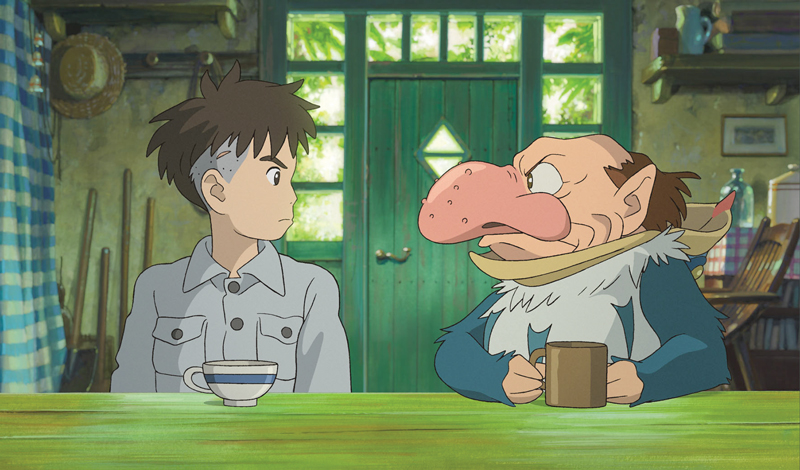This series highlights how Buddhism can enhance daily living. As Nichiren Daishonin says: “When the skies are clear, the ground is illuminated. Similarly, when one knows the Lotus Sutra, one understands the meaning of all worldly affairs.”[1]
In The Boy and the Heron, the 2024 Oscar-winning animated feature by Hayao Miyazaki, 11-year-old Mahito Maki struggles to cope with losing his mother.
Set in World War II Japan, his family moves to the countryside to escape their war-torn city. There, Mahito encounters a talking grey heron who entices him to search for his deceased mother in an abandoned tower, finding in it a fantastical world.
Mahito eventually meets the sorcerer who built this magical realm—his Granduncle—who implores Mahito to succeed him as the realm’s architect and guardian.
The story leaves room for interpretation, but we can discern an essential question: What does it mean to be a successor?
A Legacy of Successors
Finding successors is a through line of the Lotus Sutra. In it, Shakyamuni Buddha conveys his culminating teaching for leading all people to enlightenment and seeks spiritual heirs who can continue spreading it far into the future. It is a story of entrustment from Shakyamuni to the Bodhisattvas of the Earth, who are described as having profound wisdom, firm resolve and great perseverance to carry out their mission to spread Buddhism amid troubled times.[2]
Nichiren Daishonin also validated the sutra’s teachings by overcoming fierce opposition. When farmers in the village of Atsuhara embraced his teaching of Nam-myoho-renge-kyo and developed faith strong enough to withstand harsh persecution[3]—just as he had—he confirmed that he had fulfilled his life’s purpose. They demonstrated that Nichiren Buddhism is a teaching that can be championed by ordinary people and lead all people to enlightenment.
Today, due to the leadership of the three founding Soka Gakkai presidents—Tsunesaburo Makiguchi, Josei Toda and Daisaku Ikeda—the Soka movement is directly aligned with the spirit of the Lotus Sutra and the Daishonin to advance kosen-rufu for the peace and happiness of all people.
As Nichiren Buddhism spreads throughout the world, it is inspiring generation after generation to establish roots of respect and equality in their lives and society as they realize their goals and contribute to the betterment of the world.
Capable People Raise Capable Successors
Ikeda Sensei described how Mr. Toda entrusted youthful successors with the future of kosen-rufu:
In The Record of the Orally Transmitted Teachings, Nichiren teaches that nam of Nam-myoho-renge-kyo means “dedication,” explaining that in dedicating our lives to the Mystic Law, we can draw forth the wisdom to take on all changing circumstances.5 “Dedication” also means vowing to enact our inner transformation and help others do the same.
After Mr. Toda appointed me youth division chief of staff, he never gave me specific instructions about what to do. He trained us youth to take full responsibility and think for ourselves. …
Standing alone—striving with this determination was the only way for us to respond to our mentor’s profound expectations.[4]
Sensei has said that fostering successors is the tradition of the Soka Gakkai, adding:
The greatest treasure we can leave for the future is capable successors. And it is those who discover and nurture individuals of promise who are themselves truly capable. Through this process of fostering others, we polish and develop ourselves.[5]
The greatest treasure we can leave for the future is capable successors. And it is those who discover and nurture individuals of promise who are themselves truly capable. Through this process of fostering others, we polish and develop ourselves.6
Just as Mahito grows through the choices he makes during his adventures, there are countless ways to realize our shared vow with our mentor and to advance kosen-rufu. As we aim toward the Soka Gakkai 100th anniversary in 2030, we can traverse our chosen path, confident that our struggles and accomplishments today are laying the foundation for generations of Soka successors 100 and 200 years into the future!
—Prepared by the SGI-USA Study Department
May 3, 2024, World Tribune, p. 11
References
- “The Object of Devotion for Observing the Mind,” The Writings of Nichiren Daishonin, vol. 1, p. 376. ↩︎
- See The Lotus Sutra and Its Opening and Closing Sutras, p. 256. ↩︎
- Atsuhara Persecution: A series of threats and acts of violence against the Daishonin’s followers in Atsuhara Village (in present-day central Shizuoka Prefecture), starting around 1275 and continuing until around 1283. ↩︎
- 5. See The Record of the Orally Transmitted Teachings, p. 3. ↩︎
- The Wisdom for Creating Happiness and Peace, vol. 3, revised edition, p. 403. ↩︎
You are reading {{ meterCount }} of {{ meterMax }} free premium articles

